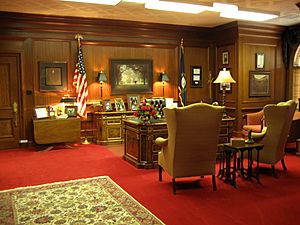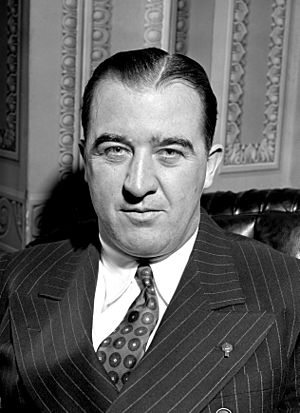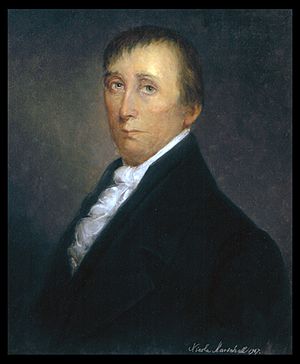Governor of Kentucky facts for kids
Quick facts for kids Governor of theCommonwealth of Kentucky |
|
|---|---|

|
|

|
|
| Government of Kentucky | |
| Style | Governor (informal) The Honorable (formal) His Excellency (diplomatic) |
| Member of | Kentucky Executive Branch Kentucky Cabinet |
| Residence | Kentucky Governor's Mansion |
| Appointer | Popular vote
Line of succession
|
| Term length | Four years, renewable once consecutively |
| Constituting instrument | Constitution of Kentucky |
| Inaugural holder | Isaac Shelby |
| Formation | June 4, 1792 |
| Succession | Line of succession |
| Deputy | Lieutenant Governor of Kentucky |
| Salary | $164,355 (2023) |
The Governor of Kentucky is the main leader of the state government in Kentucky. Many people have been governor of Kentucky, including 62 men and one woman. A governor serves for four years. Since 1992, a governor can run for re-election one time. After serving two terms, they must wait four years before running again.
Four people have served two terms that were not back-to-back. Four others have served two terms in a row. The current governor, Andy Beshear, was re-elected for his second term on November 7, 2023. Kentucky is one of only five U.S. states that hold governor elections in "off-years." These are years when there is no presidential election.
The governor's powers are listed in the state constitution. Kentucky has had four constitutions, created in 1792, 1799, 1850, and 1891. Each new constitution gave the governor more power. The governor can forgive crimes, reject new laws, and call the state's law-making group, the Kentucky General Assembly, into special meetings.
The governor is also the leader of Kentucky's military forces, like the Kentucky National Guard. They make sure all state laws are followed. The governor also chooses many people to work in the state government. This power has made the Kentucky governor's job one of the strongest in the United States.
Historically, one political party usually controlled the governor's office for a long time. Early on, the Democratic-Republicans won every election until 1828. Then, the Whig Party took over until 1851. After the Whig Party ended, Democrats were mostly in charge until 1895.
From 1895 to 1931, both Republicans and Democrats had a chance to be governor. Since 1931, mostly Democrats have been elected. Only four Republicans have served as governor in that time, and none have been re-elected.
Contents
What the Governor Does
The Kentucky Constitution lists the governor's main jobs. One of the first is to be the commander-in-chief of the state's military. In 1799, a rule was added that the governor would not lead troops in battle unless the Kentucky General Assembly agreed. This happened in 1813 when Governor Isaac Shelby led Kentucky troops in a battle.
Other powers include making sure all laws are followed. The governor can also fill empty elected jobs until the next meeting of the General Assembly. They can also forgive fines and grant pardons (officially excuse someone from a crime). Forgiveness for treason (betraying the state) is only temporary. The General Assembly must approve a full pardon for treason.
The 1891 constitution added that the governor must explain why they grant a pardon. This explanation must be open for everyone to see. In the past, power in Kentucky's government was shared among many elected officials. But in recent times, more power has moved to the governor's office.
Calling and Ending Legislative Meetings
The governor can make the General Assembly take a break for up to four months if the two parts of the legislature cannot agree on when to stop meeting. The governor can also call special meetings of the General Assembly for "extraordinary occasions."
Since 1799, the governor has been able to call the legislature to meet somewhere other than the capital city, Frankfort, Kentucky. This could happen if the capital became unsafe due to enemies or diseases. This rule was important when diseases like smallpox were a big danger.
The 1891 constitution added that the governor must say why they are calling a special meeting. Only those specific topics can be discussed during that meeting. However, the legislature does not have to do any work during the special session. In 2007, Governor Ernie Fletcher called a special session. The House of Representatives, controlled by Democrats, did not think the topics were urgent. They met for an hour and then left without doing anything.
How the Governor Can Veto Laws
The governor has the power to reject new laws, which is called a veto. If the governor does not sign or veto a bill, it automatically becomes law after 10 days. If the legislature ends its meeting before the governor can send a bill back, the bill becomes law three days after the next meeting, unless the governor vetoes it.
The 1799 constitution first gave the governor the power to veto laws. The 1891 constitution gave the governor a "line-item veto." This means they can reject specific parts of a spending bill without rejecting the whole thing. However, they cannot use this veto on changes to the constitution or tax laws. The legislature can overrule a governor's veto with a simple majority vote in both houses. In most states, a larger vote is needed to overrule a veto.
Managing the State Budget
In many states, the legislature creates the state budget. But in Kentucky, the governor must present a suggested budget for two years to the General Assembly. This happens at the start of their meetings in even-numbered years. The governor's budget is often approved with few changes.
However, since Republicans gained control of the Kentucky Senate in 1999, approving the budget has become more difficult. In 2002 and 2004, the General Assembly did not pass a budget on time. The state then operated under a spending plan made by the governor. In 2005, the Kentucky Supreme Court ruled that the governor could not spend money without the legislature's approval. If no budget is passed, only spending allowed by the constitution can happen.
Running the Government and Making Choices
The Kentucky constitution says the governor leads the state's executive branch. But it does not say exactly how they should do this. The first constitution allowed the governor to choose all elected officials. But later constitutions changed this, making more of those jobs elected by the people.
Because the constitution does not list every detail, the governor has relied on laws passed by the General Assembly. These laws created many groups and committees that report to the governor. This has given the governor a lot of power over state government.
By 1934, the executive branch had 69 different groups and agencies. Governor Ruby Laffoon suggested a plan to organize these groups into 17 main departments. The General Assembly passed this law, giving the executive branch a clearer structure.
Governor Happy Chandler continued this work in 1936. He created 10 main departments and an Executive Cabinet. This cabinet included elected officials and the heads of the new departments. Chandler's changes helped the state pay off most of its debt. His plan also clearly gave the governor the power to choose department heads and organize departments. Later laws gave the governor even more power to manage state employees and rules.
By 1971, the executive branch had grown again, with 60 departments and 210 groups reporting to the governor. Governor Wendell Ford reorganized the government in 1973. He combined departments into six main "program cabinets." By the end of that year, there were only three program cabinets and four other departments.
By 2002, the executive branch had 14 cabinets. In 2003, Governor Ernie Fletcher made the last major reorganization. He reduced the number of cabinets to nine.
The governor chooses about 2,000 people for various state jobs. This is why the office is seen as very powerful. The governor also has a lot of freedom in giving out state contracts. This adds to their influence. In the second half of the 1900s, efforts were made to stop governors from using these choices for political favors. Governor Happy Chandler created a system that stopped hiring or firing state employees for political reasons.
Unofficial Powers of the Governor
Many people believe the governor's unofficial powers are as important as their official ones. These powers come from tradition and custom. Governors are often the leaders of their political parties in the state. They usually control who represents their party at state and national meetings.
Even though the governor has few official powers over the legislature, they can greatly influence the General Assembly. They often help choose the leaders of both parts of the legislature. However, the legislature has become more independent since the late 1900s. This started during Governor John Y. Brown Jr.'s time (1979-1983). He was less involved in legislative matters.
The governor is also the most visible state official. They are the center of political attention in Kentucky. The governor hosts important visitors and gives speeches at events. They also appear on national television with the winner of the annual Kentucky Derby. The state constitution requires the governor to give a speech to the legislature about the "state of the Commonwealth." This speech is often for the citizens as much as for the lawmakers. The governor uses it to talk about their achievements and plans. The news media pays a lot of attention to the governor's actions. Strong governors have used the media to gain support and criticize opponents.
Who Can Be Governor?
To be governor of Kentucky, a person must be at least 30 years old. They must also have lived in the state for at least six years before the election. The residency rule was changed from two years to six years in the 1799 constitution. The 1792 constitution made an exception for people who were away on government business. The age rule was raised to 35 in 1799 but returned to 30 in 1891.
The first three constitutions said a person could not be governor and hold a federal job at the same time. This rule is not in the current constitution. The 1799 constitution also said that a "minister of any religious society" could not be governor. This rule was removed in the 1891 constitution.
The 1891 constitution added a rule against dueling. It said that anyone who had fought a duel with a deadly weapon could not hold any state office, including governor. This rule showed how common dueling was in the South at that time. The governor's oath of office still includes a promise not to have dueled.
The governor's term has always been four years. The 1792 constitution did not limit how many terms a governor could serve. But the 1799 constitution said a governor could not be re-elected for seven years after their term ended. This rule did not apply to the governor at the time, James Garrard, who was re-elected in 1799. The 1850 constitution shortened the waiting period to four years, and it stayed that way in the 1891 constitution.
In 1953, Governor Lawrence Wetherby complained about the term limit. He said it was hard for a governor to get things done in their first 90 days, especially with the legislature only meeting every two years. The idea of removing the term limit was first discussed in 1850 but was strongly opposed.
It was not until 1992 that the state constitution was changed. This change allowed the governor to serve two terms in a row. Governor Brereton C. Jones helped pass this change. He agreed that the new rule would not apply to governors already in office. Paul E. Patton was the first governor to be elected to two terms in a row after this change. Another change in 2000 created a 30-day legislative session in odd-numbered years. This was in addition to the longer 60-day sessions in even-numbered years.
How the Governor is Chosen
In the 1792 constitution, the governor was chosen by electors, similar to how the U.S. President is chosen. In the 1795 election, Benjamin Logan received the most votes, but not a majority. The electors then held a second vote, and James Garrard won. The constitution did not say what to do in this situation.
The 1799 constitution changed this to a direct election by the people. If there was a tie, the governor would be chosen by drawing lots in the General Assembly. This rule has stayed the same since 1799.
Later, political parties started choosing their candidates for governor at special meetings called "nominating conventions." Thomas Metcalfe was the first governor candidate chosen this way in 1827. Governor Ruby Laffoon, elected in 1931, was the last governor chosen by a convention. His lieutenant governor, Happy Chandler, pushed for parties to use primary elections instead. This means voters choose the candidates in an earlier election. Primary elections are still required by law today. In 1992, the constitution was changed to require candidates for governor and lieutenant governor to run together as a team.
Kentucky is one of only five U.S. states that hold governor elections in odd-numbered years. The others are Louisiana, Mississippi, Virginia, and New Jersey. The general election for governor and lieutenant governor is held on the first Tuesday after the first Monday in November. The governor and lieutenant governor are sworn into office on the fifth Tuesday after their election.
Who Takes Over if the Governor Can't Serve?
Under Kentucky's first constitution (1792), if the governor died, resigned, or was removed, the leader of the state Senate became acting governor until a new election. The 1799 constitution created the job of lieutenant governor. The lieutenant governor became governor if the sitting governor died, resigned, or was removed. They also acted as governor if the governor was out of the state.
The 1850 constitution added that if the governor's term had more than two years left, a special election would be held. The lieutenant governor would serve until then.
The 1891 constitution made the line of succession longer. If the Senate was not meeting, the secretary of state, or then the attorney general, would become acting governor. They would then call the Senate to meet to elect a new leader, who would become governor. A 1992 change to the constitution removed the rule about the lieutenant governor acting as governor when the governor was out of state. It also changed the lieutenant governor's duties in the Senate. The current line of succession is:
- Governor (Andy Beshear)
- Lieutenant Governor (Jacqueline Coleman)
- President of the Senate (if the Senate is meeting) (Robert Stivers)
- Attorney General (if the Senate is not meeting) (Russell Coleman)
- State Auditor (if the Senate is not meeting and the Attorney General cannot serve) (Allison Ball)
If the attorney general or state auditor becomes governor, they must call the Senate to meet and elect a president, who would then become governor.
The first time a governor was replaced in Kentucky was when Governor George Madison died in 1816. He died of tuberculosis just three weeks into his term. His lieutenant governor, Gabriel Slaughter, became governor. Slaughter made some unpopular choices. Some people in the House of Representatives wanted a new election for governor. They said Slaughter was only "acting governor." This idea failed. Slaughter served out the rest of Madison's term. This set the rule that the lieutenant governor would permanently take over if the governor died, resigned, or was removed.
Besides Madison, four other governors have died in office: John Breathitt, James Clark, John L. Helm, and William Goebel. All died of natural causes except Goebel. He is the only governor in any U.S. state to have been assassinated. Goebel lost the close 1899 election to William S. Taylor. While the General Assembly was looking into the election results, Goebel was shot. Days later, the General Assembly decided Goebel had won, making him governor. Goebel was sworn in while sick in bed and died two days later. His lieutenant governor, J. C. W. Beckham, took over.
Seven men have resigned as governor before their term ended. Six resigned to take a higher job, usually in the United States Senate. Only Beriah Magoffin resigned because of pressure. He was a supporter of the Confederacy during the American Civil War. The state legislature was against him, so he had little power. To end the conflict, Magoffin agreed to resign if he could choose who would replace him. His lieutenant governor had died. The leader of the Senate was not acceptable to Magoffin. So, that leader resigned, and the Senate elected Magoffin's choice. Magoffin then resigned, and his choice became governor.
All elected officials in Kentucky, including the governor, can be removed from office for "misdemeanors in office." The House of Representatives brings the charges, and the Senate holds the trial. If found guilty, the governor is removed and might not be able to hold elected office again. No Kentucky governor has ever been removed from office this way.
Where the Governor Lives and How Much They Earn
Each Kentucky Constitution has said that the governor should receive a salary. The first three constitutions said the governor's salary could not change while they were in office. This rule now applies to all public officials. The governor's salary is set by law. In 2014, the governor's salary was $186,730.
The Kentucky Governor's Mansion is the official home of the governor. The current mansion was built in 1914. It is located at 704 Capitol Avenue in Frankfort, Kentucky. It is the second building to be the governor's official home. The law says the governor can use the mansion and its furniture for free.
The state's first governor's mansion was built when James Garrard was governor. It is said that future governors Thomas Metcalfe and Robert P. Letcher helped build it. After the new mansion was built, the old one became the home of the lieutenant governor. Lieutenant Governor Steve Henry moved out in 2002 so it could be fixed up. After renovations, it became a state guest house and a place for the governor to host events. For many years, it was the oldest official residence still in use in the United States. It is located at 420 High Street in Frankfort.
History of the Governor's Office
Political parties existed in the United States before Kentucky became a state. Most early Kentuckians were from Virginia. They usually supported the Democratic-Republican Party. This was the party of Thomas Jefferson and James Madison. Few Federalists won in Kentucky, and no Kentucky governor was a Federalist. Military service was very important to voters in early elections. John Breathitt, elected in 1832, was the first Kentucky governor who had not served in the military.
The Federalist Party ended by 1820. But new party groups soon formed in Kentucky. The Panic of 1819 left many Kentuckians in debt. Two groups formed around the issue of debt relief. One group wanted laws to help debtors, called the "Relief Party." The other group wanted laws to protect those who were owed money, called the "Anti-Relief Party." These groups shaped Kentucky politics in the 1820s.
Many Anti-Relief supporters later joined the National Republican Party, which became the Whig Party. From 1828 to 1851, only one Democrat, John Breathitt, was governor. He died during his term, and a National Republican took over.
After the Whig Party ended in the 1850s, many former Whigs joined the Know Nothing Party. Charles S. Morehead was elected governor from that party in 1855. Tensions grew in the state before the Civil War. Most Kentuckians wanted to stay with the Union. But some Confederate supporters formed a separate Confederate government for the state. This government never replaced the elected government in Frankfort.
From the end of the Civil War until 1895, Kentucky elected a series of Democrats who had supported the Confederacy. This included two men who had served in the Confederate Army. The Democratic control was broken when William O'Connell Bradley was elected the state's first Republican governor in 1895. This started 30 years of real competition between the two parties for the governorship. Between 1895 and 1931, five Republicans and six Democrats held the office. Since 1931, Republicans have not had as much success. Only four of the 20 elected governors since then have been Republican.
Timeline of Governors
| Timeline of Kentucky governors |
 |
See also
- 2023 Kentucky gubernatorial election – the most recent election for governor






